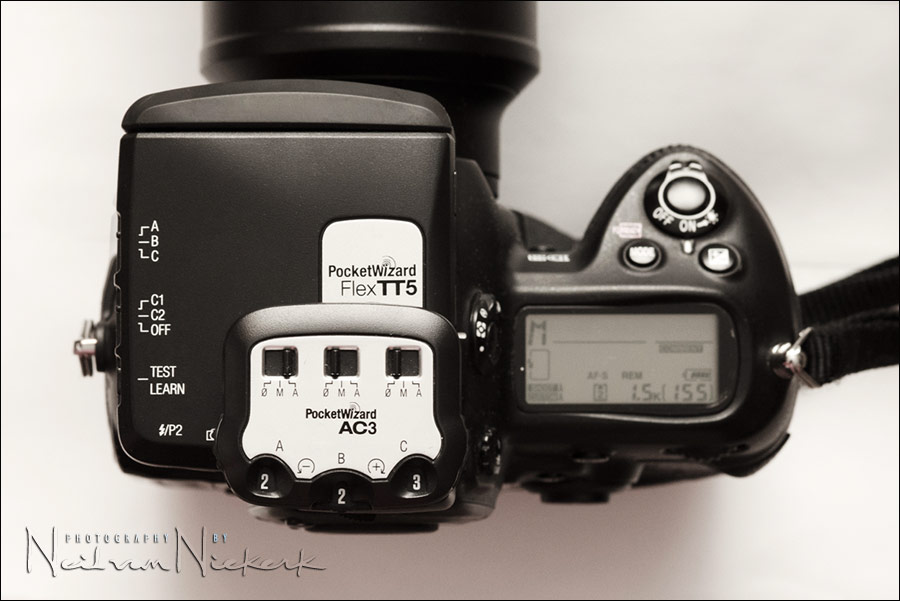
using the PocketWizard AC3 Zone Controller
This portrait of musician, Josh Adams, was a fairly quick set-up. I deliberately chose an area in a large hotel conference room to shoot this. A bit of a challenge to see how quickly I could get a simple but dramatic portrait out of a ‘nothing’ scenario. Here’s the pull-back shot that will show you the area, as well as the placement of the lights:

The light came from three speedlights, all controlled with the PocketWizard FlexTT5 transceivers. They in turn were controlled via an on-camera FlexTT5 (for Nikon), with an AC3 Zone Controller piggy-backing on the TT5. Using the AC3 Controller made it a breeze to control the output (and mode) of each of the three speedlights. I could switch any of them to manual, or to TTL. I could control the TTL units’ Flash Exposure Compensation from the ACR3. And I could control the manual output, if I had decided to switch the speedlight to manual mode. All from my camera …

Of course, features such as:
– wireless controlled TTL flash, and
– high-speed flash sync,
are not features exclusive to these types of radio controllers. That’s inherent in the Nikon or Canon (or other manufacturers’) wireless flash systems themselves.
Where the newer generation of radio transmitters & receivers like the PocketWizard MiniTT1 and FlexTT5 have their real use, is in allowing all this without the line-of-sight restrictions.
With this portrait of Josh, two flashes are hidden behind him. Trying to control the two speedlights in the back with just an on-camera speedlight set to Master, would be a headache due to the misfires that will surely happen. So you do need radio transmitters and receivers to control the flash’s output in situations like this.
With the MiniTT1 and FlexTT5, you could do this via the speedlight mounted on the TT1 / TT5. However, the AC3 simplifies this to just a set of dials and switches. Immediately accessible.
camera settings: 1/200 @ f4 @ 400 ISO
Back to the portrait of Josh:
– the speedlight in the front (with the small Lastolite softbox), was kept to TTL flash;
– the speelight in the middle was set to Manual, and 1/32 power
– the speedlight in the back was also set to Manual, and 1/32 power.
As mentioned, changing any of these, would be a simple turn of a dial on the AC3. Simplicity.
I really think the AC3 Zone Controller makes the new PocketWizards even easier to use, giving you immediate access from your camera.
equipment used
PocketWizard AC3 Zone Controller (B&H)
PocketWizard FlexTT5 transceiver (B&H)
Nikon D3; Nikon 70-200mm f2.8 AF-S II (B&H);
Nikon SB-900 (B&H); Nikon SD-9 battery pack (B&H)
Manfrotto 1051BAC (B&H) Lastolite 8.6″ Ezybox (B&H)
Oh, and the speedlight in the back, throwing the diagonal blast of light on the wall, had two black foamie things to act as a snoot to shape the light like that.
camera settings: 1/200 @ f4 @ 400 ISO
related articles
– photo session – Shawna – using the PocketWizard AC3 ZoneController
– Keegan – a photo session – using PocketWizard MiniTT1 & FlexTT5 & AC3 ZoneController
Thanks again Neil for another great post! I have been waiting for these to come out and would like to ask if there was a learning curve to overcome during the initial set up? I have been using the standard pocket wizards for a long time and have been comfortable with them, but would love higher sync speed capabilities for shooting outdoors in all lighting conditions as well and indoor receptions. Are these a worthy upgrade?
Thanks,
Nate
Hi,
Thank you for the pull back shot. It always look simple but somehow when I try to do it, it gets much more difficult don’t know why :)
By the way, I am using some other flash trigger that I find perfect for my occasional use, the model is Pixel tr 332, it also handles high sync speed,ttl, FEC. The only things I don’t like is that ratio cannot be set up between groups in ttl and I also don’t like the battery type.
Hi Neil
Thanks for this great site!
I was wondering why you couldn’t have achieved this same look by just having all 3 speed-lights kept on TTL?
There for excluding the need for the AC3.
Thanks again
Mike
“A bit of a challenge to see how quickly I could get a simple but dramatic portrait out of a ‘nothing’ scenario”
Indeed a crummy looking room to produce anything in and yet you achieved it. Excellent image.
Why the AC3? Do you not own an SU800 or do you prefer the smaller size of the AC3?
Sorry if I didn’t make myself clear there.
I meant using the SU800 in conjunction with the TT5 / TT1 to bypass the line of site issues yet still get the same control of remote flashes from the camera as what the AC3 gives you.
Hi Neil.
I count 4 Flex tt5s. No Need for the Mini TTI?
Fred
@Mike, Derek.. it should be line of sight issues I guess..
Neil, when fiddling with the M & A options on the ACZC, were your SBs in TTL mode all along? I am waiting for the ACZC to hit Asia. I have my new Minis and Flexes. Love them
Sorry Neil. Just read the last bit of the article. Your other two flashes were set to Manual. I thought I read that the flashes have to be in TTL for the M & A options to work. It would have been easier. Otherwise, does this mean that you have to switch the SB from Manual back to TTL on the unit itself.
Neil,
I found this site last week, and have just been amazed by it’s content. The way you explain things so clearly and concisely , and the content you cover, are second to none. I am particularly impressed by the individual attention, and replies, that any and all questions receive.
What a breath of fresh internet air.
And so to my question… I don’t suppose you’ve used the Pocket Wizard system you cover in this article, with older non i-TTl flashes, in manual mode? I’m thinking SB80DX’s, SB28’s, SB26’s and the like?
Thanks as ever Neil for this site.
The pull-back shot is such a great idea – really allows everything to fall into place,
Great portrait BTW.
Best, P:)
Another great, succinct demystifier, Neil. I was ready to buy this set-up and may not have included the AC3 and had to have one speedlight on the camera as master or buy a fourth at much greater expense than the AC3. So this pricy pocket wizard system suddenly seems a bit more reasonable cost-wise.
Great blog…as usual. You used the smallest EZ BOX soft box in a large room setting. Are you using this instead of the larger ones because it is easier to pack broken down with your equippment or do you seem to prefer the quality of double baffled light it produces.. or both ? I am still awaiting for the one I ordered from b&h
Hi, great post! But I was always wondering if you could just put an trasnmitter on a hot shoe and could then control other recievers through Nikons built-in menu of CLS. So to control flashes (not just to fire them) you actually need this AC3?
Thank you!
Nice work; Thx for sharing all this. ;)
Neil,
Love the colour and slash of light on the background.
Any reason you chose the Pocket Wizards over the Radio Poppers you tried a while back?
Brian
@Joe Leong
Yes the flashes stay in TTL but the commander unit (in my case the SU800) tells the remotes to go to manual mode, no need to walk over to the flash and put it in manual, it always stays set to TTL but the control tells it to fire manual.
I dont own the AC3 but I believe it works very similar to the SU800
@Derek
I have been using the pop-up and SB900 as master for a while and waited for the new PWs for Nikon. So I am very familiar with CLS. I started shooting manually few months ago with the aid of a light meter. ‘Just waiting for the AC Zone Controller in my part of the world.
Yes it would make sense that the ACZC should work like the SU800 only that Neil mentioned this in the forum :
Quote :
– the speedlight in the front (with the small Lastolite softbox), was kept to TTL flash;
– the speelight in the middle was set to Manual, and 1/32 power
– the speedlight in the back was also set to Manual, and 1/32 power.
The middle and back flashes were in Manual mode.
At the moment, or at least until I get the ACZC, it’s a theory for me
Thanks Derek
I just ordered my AC3 for Nikon. Quite excited.
Question for anyone:
When using it set to manual to control an SB-900, for instance, which can go as low as 1/128th power, how can you reach that power level on the AC3 when it only goes to -3… AKA 1/64th?
I guess the PW config utility can allow you to pick which range to use, from 1/1 to 1/64th or 1/2 to 1/128th, is that correct? But that seems a bit silly. Would you just use exposure comp on the camera dialed in to -1 or something to get the equivalent of 1/128th, or what?
Thanks!
I have been using the AC3 zone controller for canon for a while now and it makes wedding photography using off camera flashes so much easier and quicker. It’s a wedding photographers dream I tell you.
Wicked post Neil, just pre-ordered the book (later release here in the UK) as I love your simple explanations. Thanks!
Scusa se ti disturbo Neil,
ho una canon eos 5d, avevo deciso di acquistare il mini TT1 e il Flex TT5, ho visto adesso dai tuoi scatti che hai utilizzato l’AC3.
Mi chiedo l’AC3 sostituisce il TT1 o bisogna comprarli tutti e due?;
con l’AC3 è possibile regolare la potenza dei flash ausiliari in manuale?
Grazie, Saro
p.s.: puoi rispondermi via e-mail?